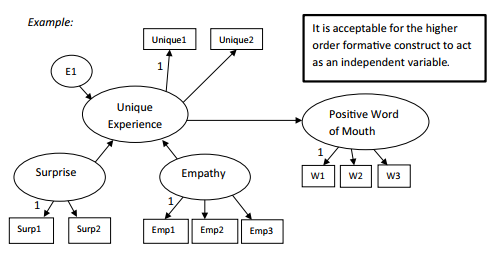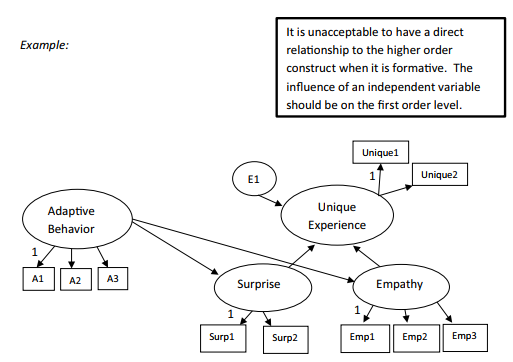As stated earlier, a formative construct is defined by its indicators. A change in a formative unobserved construct cannot take place without a change also taking place in the indicators. Hence, I think it is a good idea to discuss the appropriate way to model relationships in a SEM model with formative constructs. If a formative construct is directly influenced by its indica- tors, then any antecedent/predictor constructs must have a relationship to these indicators instead of the higher order construct. A common mistake is for a predictor construct to have a direct relationship to a higher order formative construct. The higher order construct can- not change without a change in the first order constructs. Thus, if a formative construct is a dependent variable, the predictor construct needs to form a relationship to the first order constructs to have an influence on the overall formative construct. For further discussion on why endogenous formative constructs need to have relationships modeled on the first order level, see Lee and Cadogan (2013).
While relationships for dependent formative constructs need to be modeled on the first order level, this same requirement is not necessary when the formative construct is a predic- tor or independent variable. When a formative construct is treated as an independent vari- able, the relationship can be modeled from the higher or second order level. A higher order formative construct is an index of the first order influences and the overall effect needs to be used as the predictor.Thus, relationships can be modeled from the higher order level when the formative construct is a predictor of another construct.

Figure 4.45a Second Order Constructs as Independent and Dependent Variables

Figure 4.45b Second Order Constructs as Independent and Dependent Variables
Source: Thakkar, J.J. (2020). “Procedural Steps in Structural Equation Modelling”. In: Structural Equation Modelling. Studies in Systems, Decision and Control, vol 285. Springer, Singapore.

27 Mar 2023
29 Mar 2023
28 Mar 2023
28 Mar 2023
28 Mar 2023
27 Mar 2023